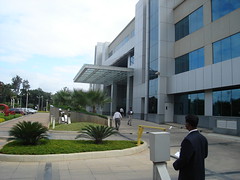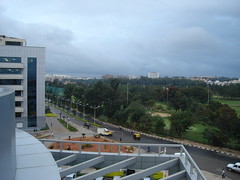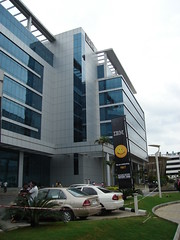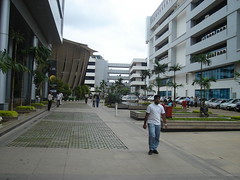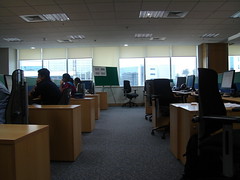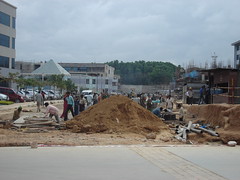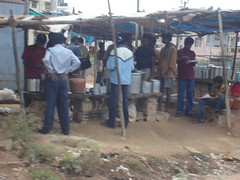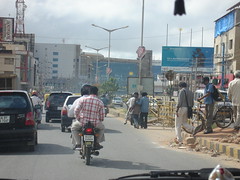I know that before I went to Bangalore I was really interested in what the physical environment would be like, so I want to share these photos from the business side of things (the more general side will need to wait until more photos get uploaded). If you'd like to hear more about our personal life in India, have a look at Amanda's blog.
The office building that I was working in was part of an IT campus, right next door to the golf course, that also included IBM and Microsoft (Microsoft is down where the bridge is in the photo). You might think from these pictures that it was a very western environment, and it certainly was inside the buildings , but outside, where building was still in progress, the contrasts became more apparent. The roads were kept clean by people with horsehair brooms who came out at night (the brooms looked just like the one that our maid used, with short handles that meant that you needed to bend over to use them), and when you look at the picture of the building site (right next to our office), note how many people and few machines you see. Construction here is very labour intensive.
Bangalore was a study in contrasts. The house next door to our apartment was palatial (and apparently occupied by late teen boys who wouldn't have been out of place cruising Chapel St, doof doof music blaring), but two doors further up the street the garbage pile was being browsed by cows and goats, and the ironing was being done by the side of the road, with charcoal powered irons. My office had a very pleasant cafeteria, but less than a kilometre away this is where breakfast was being served (sorry for the blurring, but the car was moving!).
Traffic was roughly equivalent to peak hour on Hoddle St in Melbourne, but a lot more chaotic. Horns are used to indicate "I'm here", since lanes, indicators and overtaking are all rather free form. Auto rickshaws fill the gaps between the cars, motorcycles fill the gaps between the autos, and there are usually some bicycles thrown in just for good measure. Rapid construction leaves the footpaths a bit of a mess, so there are frequently pedestrians on the roads, though it doesn't making crossing the road any easier.
